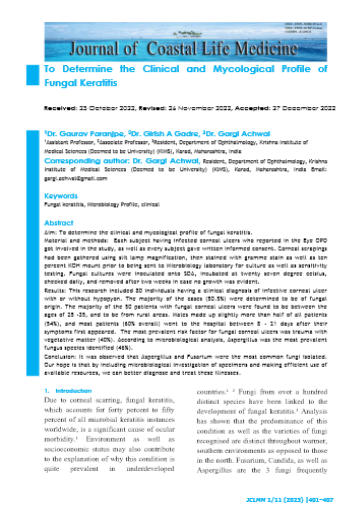To Determine the Clinical and Mycological Profile of Fungal Keratitis
Main Article Content
Abstract
Aim: To determine the clinical and mycological profile of fungal keratitis.
Material and methods: Each subject having infected corneal ulcers who reported in the Eye OPD got involved in the study, as well as every subject gave written informed consent. Corneal scrapings had been gathered using slit lamp magnification, then stained with gramme stain as well as ten percent KOH mount prior to being sent to Microbiology laboratory for culture as well as sensitivity testing. Fungal cultures were inoculated onto SDA, incubated at twenty seven degree celsius, checked daily, and removed after two weeks in case no growth was evident.
Results: This research included 80 individuals having a clinical diagnosis of infective corneal ulcer with or without hypopyon. The majority of the cases (50.5%) were determined to be of fungal origin. The majority of the 50 patients with fungal corneal ulcers were found to be between the ages of 25 -35, and to be from rural areas. Males made up slightly more than half of all patients (54%), and most patients (60% overall) went to the hospital between 8 - 21 days after their symptoms first appeared. The most prevalent risk factor for fungal corneal ulcers was trauma with vegetative matter (40%). According to microbiological analysis, Aspergillus was the most prevalent fungus species identified (46%).
Conclusion: It was observed that Aspergillus and Fusarium were the most common fungi isolated. Our hope is that by including microbiological investigation of specimens and making efficient use of available resources, we can better diagnose and treat these illnesses.
Article Details
References
Castano, G.; Elnahry, A.G.; Mada, P.K. Fungal Keratitis; StatPearls: Treasure Island, FL, USA, 2022.
Acharya, Y.; Acharya, B.; Karki, P. Fungal keratitis: Study of increasing trend and common determinants. Nepal J. Epidemiol. 2017, 7, 685–693.
Xie, L.; Zhai, H.; Zhao, J.; Sun, S.; Shi, W.; Dong, X. Antifungal Susceptibility for Common Pathogens of Fungal Keratitis in Shandong Province, China. Am. J. Ophthalmol. 2008, 146, 260–265.e1.
Kowalski, R.P.; Nayyar, S.V.; Romanowski, E.G.; Shanks, R.M.; Mammen, A.; Dhaliwal, D.K.; Jhanji, V. The Prevalence of Bacteria, Fungi, Viruses, and Acanthamoeba from 3004 Cases of Keratitis, Endophthalmitis, and Conjunctivitis. Eye Contact Lens 2020, 46, 265–268.
Mahmoudi, S.; Masoomi, A.; Ahmadikia, K.; Tabatabaei, S.A.; Soleimani, M.; Rezaie, S.; Ghahvechian, H.; Banafsheafshan, A. Fungal keratitis: An overview of clinical and laboratory aspects. Mycoses 2018, 61, 916–930.
Ritterband, D.C.; Seedor, J.A.; Shah, M.K.; Koplin, R.S.; McCormick, S.A. Fungal Keratitis at the New York Eye and Ear Infirmary. Cornea 2006, 25, 264–267.
Tanure, M.A.G.; Cohen, E.J.; Sudesh, S.; Rapuano, C.J.; Laibson, P.R. Spectrum of Fungal Keratitis at Wills Eye Hospital, Philadelphia, Pennsylvania. Cornea 2000, 19, 307–312.
Manikandan, P.; Abdel-Hadi, A.; Randhir Babu Singh, Y.; Banawas, S.; Dukhyil, A.A.B.; Alshehri, B.; Shobana, C.S.; Selvam, K.P.; Narendran, V. Fungal Keratitis: Epidemiology, Rapid Detection, and Antifungal Susceptibilities of Fusarium and Aspergillus Isolates from Corneal Scrapings. Biomed. Res. Int. 2019, 2019, 6395840
Leck AK, Thomas PA, Hagan M, Kaliamurthy J, Ackuaku E, John M, et al. Aetiology of suppurative corneal ulcers in Ghana and south India, and epidemiology of fungal ker- atitis. Br J Ophthalmol 2002;86:1211-15.
Kotigadde S, Ballal M, Jyothiriatha , Kumar A, Rao S, Shivananda PG: Mycotickeratitis: A study in coastal Karnataka. Indian J Ophthamol 1992, 40:31-33.
Srinivasan M, Gonzales CA, George C et al. Epidemiology and aetiological diagnosis of corneal ulceration in Madurai, South India. Br J Ophthalmol, 1997; 81: 965-971.
Dr Samir Mahapatra, DrDebendra Kumar Sahu et al. Epidemiological and Microbio- logical Evaluation of Microbial Keratitis in Western Orissa: A 2 year Prospective Study in a Tertiary Care Centre. AIOC 2009 Proceedings: 304-306.
Bharathi MJ, Ramakrishnan R, Vasu S, Meenakshi R, Palaniappan R. Epidemiological Characteristics and laboratory diagnosis of fungal keratitis a three year study. Indian J Ophthalmol 2003;51:315-21.
Basak SK, Basak S, Mohante A, Bhowmick A. Epidemiological and microbiological di- agnosis of suppurative keratitis in Gangetic West Bengal, Eastern Indian J Ophthalmol 2005; 53 (1) : 17-22.
Marlon Moraes Ibrahim, Rafael Vanini et al. Epidemiology and medical predication of microbial keratitis in southeast Brazil. Arq Bras Oftalmol. 2011; 74 (1) 7-12.
Despande SD, Koppikar GV. A study of mycotic keratitis in Mumbai. Indian J Pathol Microbiol 1999;42:81-87.
Garg P, Gopinathan U, Choudhary K, Rao GN. Keratomycosis: clinical and microbiological experirnece with dematiaceous fungus. Ophthalmology 2000;107:574-80.
Sunbaram BM, Badrinath S, Subramanian S. Studies on mycotic keratitis. Mycoses 1989:32:190-97.
Houang E, Lam D, Fan D, Seal D. Microbial keratitis in Hong Kong: relationship with climate, environment, and contact lens-disinfection. Trans R Soc Trop Med Hyg 2001;95:361-67

